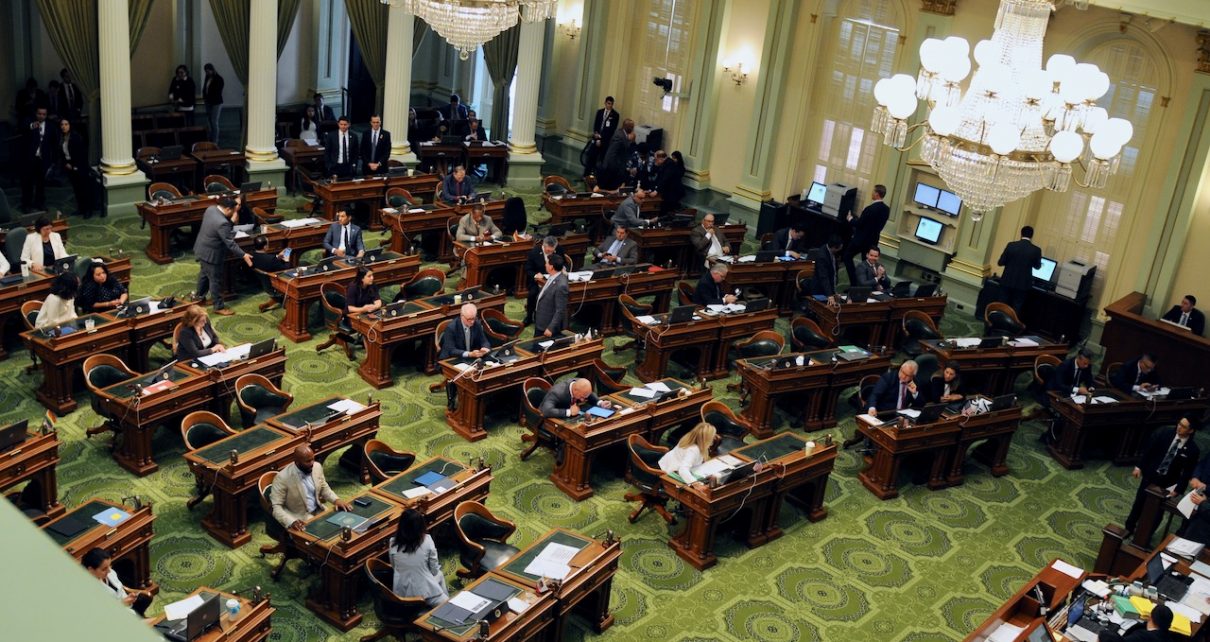
California State Assembly Chamber. (Photo: Kevin Sanders for California Globe)
Enactment of Statutes and Adoption of Resolutions
The Legislature must finish its actions on the budget required by the Constitution by June 15th of each year
By Chris Micheli, January 15, 2020 10:15 am
In California’s Government Code, there are several code sections that set forth the enactment of statutes and adoption of resolutions. These statutes were enacted in 1943 and are found in Title 2, Division 2, Part 1, Chapter 5. The provisions of law are summarized below:
Definition of Clerk – Gov’t Code Sec. 9500
The term “clerk” means the engrossing and enrolling clerk or the employee who performs the duties of engrossing and enrolling clerk when no employee is designated by name.
Definition of Committee – Gov’t Code Sec. 9501
The term “committee” means the engrossing and enrolling committee of the house ordering the engrossing or enrolling of a bill or other document or the committee of such house which performs the duties of engrossing and enrolling committee when no committee is designated by name.
Enacting Clause – Gov’t Code Sec. 9501.5
The enacting clause of every law must be “The people of the State of California do enact as follows:”.
Engrossing and Enrolling – Gov’t Code Sec. 9502
All bills and other documents ordered engrossed or enrolled by the Senate or Assembly are to be delivered by the Secretary of the Senate or Chief Clerk of the Assembly to the clerk of the house ordering the engrossment or enrollment.
Delivery to State Printer – Gov’t Code Sec. 9503
The clerk must deliver the bills and documents without delay, in the order of their receipt, to the State Printer.
Enrolled Copies of Bills – Gov’t Code Sec. 9504
The State Printer must accept all bills or documents and, without delay, engross or enroll (print) them in the order of their receipt.
Delivery by State Printer – Gov’t Code Sec. 9505
The State Printer must deliver the engrossed or enrolled copy of the bill or document, with the original, to the clerk from whom he received the original. The clerk must carefully compare the engrossed or enrolled copy with the original version. If correctly engrossed or enrolled, the individual must report it back with the original version to the committee.
Engrossing of Bills – Gov’t Code Sec. 9506
All bills and documents that have been printed must be considered engrossed if no amendments have been made after being printed. The original bill or document is to be delivered to the clerk of the house where it originated. That individual must compare the original with the printed bill or document, and deliver it to the committee for return to the house in the same manner as engrossed bills.
Presentation of Bills – Gov’t Code Sec. 9507
If the enrolled copy of a bill or other document is found to be correct, the committee must present it to the proper officers for their signatures. When the officers sign their names, as required by law, it is enrolled.
Transmittal of Enrolled Bills – Gov’t Code Sec. 9508
Enrolled bills are required to be transmitted to the Governor for his approval.
Endorsement of Enrolled Bills – Gov’t Code Sec. 9509
As soon as an enrolled bill is delivered to the Governor, it must be endorsed as follows: “This bill was received by the Governor this ____ day of ____, 20__.” The endorsement must be signed by the private secretary of the Governor or by any other person designated by the Governor whose designation has been reported to the Speaker of the Assembly and the President pro Tempore of the Senate.
Approval by the Governor – Gov’t Code Sec. 9510
When the Governor approves a bill, he must affix his name thereto, with the date of signing, and deposit it in the Office of the Secretary of State, where it becomes the official record. Upon the receipt of any bill, the Secretary of State must give it a number, to be known as the chapter number. He numbers each bill in the order in which it is received by him, and the order of numbering is presumed to be the order in which the bills were approved by the Governor.
Two Series of Bill and Resolution Chapter Numbers – Gov’t Code Sec. 9510.5
There are two series of bill chapter numbers for each two-year regular session of the Legislature. Bills deposited with the Secretary of State from the beginning of the two-year session through December 31 of the odd-numbered year are to be designated “Statutes of [odd-numbered year], Chapter ____.” Bills deposited with the Secretary of State after December 31 of the odd-numbered year are to be designated “Statutes of [even-numbered year], Chapter ____.”
Concurrent resolutions, joint resolutions, and proposed constitutional amendments adopted by the Legislature are to be chaptered as resolution chapters with a different series of numbers than those assigned to bills but must otherwise be numbered and designated in the same manner as bills enacted into law.
Appropriations Bills – Gov’t Code Sec. 9511
If a bill presented to the Governor contains an item or several items of appropriation, he may object to one or more items while approving other portions of the bill. In such a case, the Governor must append to the bill, at the time of signing it, a statement of the items to which he objects, and the reasons therefor. If the Legislature is in session, the Governor must transmit to the house in which the bill originated a copy of the statement. The items so objected to are to be separately reconsidered in the same manner as bills which have been disapproved by the Governor.
Vetoed Bills – Gov’t Code Sec. 9512
When a bill has passed both houses of the Legislature and is returned by the Governor without his signature, and with objections thereto, or if it is a bill containing an item or several items of appropriation which is returned with objections to one or more of the items, and upon reconsideration the bill, item, or items pass both houses by the constitutional majority, the bill, item, or items are then to be authenticated as having become a law by a certificate.
Certificate Attached to Vetoed Bills – Gov’t Code Sec. 9513
The certificate is to be attached to the bill, or indorsed on or attached to the copy of the statement of objections. It must be in the following form: “This bill having been returned by the Governor with his objections thereto, and, after reconsideration, having passed both houses by the constitutional majority, has become a law this ____ day of ____, ____”; or, “The following items in the within statement (naming them) having, after reconsideration, passed both houses by the constitutional majority, have become a law this ____ day of ____, ____.” A certificate signed by the President of the Senate and the Speaker of the Assembly is a sufficient authentication thereof.
Bills Deposited with Secretary of State – Gov’t Code Sec. 9514
The bill or statement authenticated is then to be delivered to the Governor, and by him deposited with the laws in the Office of the Secretary of State. Bills so deposited in the Office of the Secretary of State are to be given a chapter number.
Delivery of Veto Message – Gov’t Code Sec. 9515
If, on the day the Governor desires to return a bill without his approval and with his objections thereto the house in which it originated has adjourned for the day, he may deliver the bill with his message to the Secretary of the Senate if it originated in the Senate, Chief Clerk of the Assembly if it originated in the Assembly, or any member of the house in which it originated. Such delivery is as effectual as though returned when the house was meeting.
Period of Bill Review – Gov’t Code Sec. 9516
Every bill which has passed both houses of the Legislature, and has not been returned by the Governor within 12 days, becomes a law. It is authenticated by the Governor and is certified by the Secretary of State in the following form: “This bill having remained with the Governor 12 days, and the Legislature being in session, it has become a law this ____ day of ____, ____.” The certificate is to be signed by the Secretary of State and deposited with the laws in his office.
Every bill which has been passed by the Legislature before September 1 of the second calendar year of the biennium of the legislative session, which was in the possession of the Governor on or after September 1, and which has not been returned by the Governor on or before September 30 of that year, thereby becoming a law, is authenticated by the Governor causing the fact to be certified thereon by the Secretary of State in a specified form.
Final Action on the Budget – Gov’t Code Sec. 9517
The Legislature must finish its actions on the budget required by the Constitution by June 15th of each year.
- Frequently Asked Questions about State Agency Ethics Training - April 26, 2024
- Frequently Asked Questions about When Elected Officials Take Office - April 25, 2024
- Frequently Asked Questions About Ethics Training for Local Agencies - April 24, 2024




